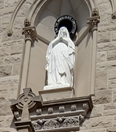Receiving (not taking) Communion: Difference between revisions
No edit summary |
m Michael Bromley moved page Recieving (not taking) Communion to Receiving (not taking) Communion: misspelled receiving |
||
| (2 intermediate revisions by the same user not shown) | |||
| Line 1: | Line 1: | ||
The '''Rite of Communion''' is the summation of the Liturgy of the Eucharist in which the failthful receive the bread and wine as the Body and Blood of Christ | The '''Rite of Communion''' is the summation of the Liturgy of the Eucharist in which the failthful receive the bread and wine as the Body and Blood of Christ. | ||
In Catholic terminology and practice one "receives" and does not "take" Holy Communion. The | In Catholic terminology and practice one "receives" and does not "take" Holy Communion. The [[Glossary of terms for catechism of the Catholic faith#Sacraments, the|Sacraments]] are gifts of the Lord worked through the Holy Spirit, and so we "receive" and do not "take" the Sacraments, including the Sacrament of the Eucharist. | ||
For an analysis of the difference between the incorrect "take | The Holy Eucharist, i.e., the Body and Blood of Christ, are "distributed" by a Eucharistic Minister (a priest, deacon, or "extraordinary minister"). | ||
The worshipper "receives" the host or chalice, which is presented to him or her by a Minister under the authority of the Bishop | |||
* see "[https://www.vatican.va/roman_curia/congregations/ccdds/documents/rc_con_ccdds_doc_20040423_redemptionis-sacramentum_en.html The distribution of Holy Communion]" in ''Instruction Redemptionis Sacramentum'' (vatican.va) | |||
For more on the Rite of Comnmunion and the distinction between "taking" and "recieving" Communion see | |||
* See here for a discussion about [[Holy Communion|Holy Communion and transfiguration]]. | |||
* Go here for an analysis of the difference between the incorrect "take" and proper "recieve" Communion: [[Blog:Recieving (not taking) Communion]] | |||
[[Category:Mass and Liturgy]] | |||
[[Category:Catechism of the Catholic Church]] | |||
Latest revision as of 15:47, 15 July 2024
The Rite of Communion is the summation of the Liturgy of the Eucharist in which the failthful receive the bread and wine as the Body and Blood of Christ.
In Catholic terminology and practice one "receives" and does not "take" Holy Communion. The Sacraments are gifts of the Lord worked through the Holy Spirit, and so we "receive" and do not "take" the Sacraments, including the Sacrament of the Eucharist.
The Holy Eucharist, i.e., the Body and Blood of Christ, are "distributed" by a Eucharistic Minister (a priest, deacon, or "extraordinary minister").
The worshipper "receives" the host or chalice, which is presented to him or her by a Minister under the authority of the Bishop
- see "The distribution of Holy Communion" in Instruction Redemptionis Sacramentum (vatican.va)
For more on the Rite of Comnmunion and the distinction between "taking" and "recieving" Communion see
- See here for a discussion about Holy Communion and transfiguration.
- Go here for an analysis of the difference between the incorrect "take" and proper "recieve" Communion: Blog:Recieving (not taking) Communion
